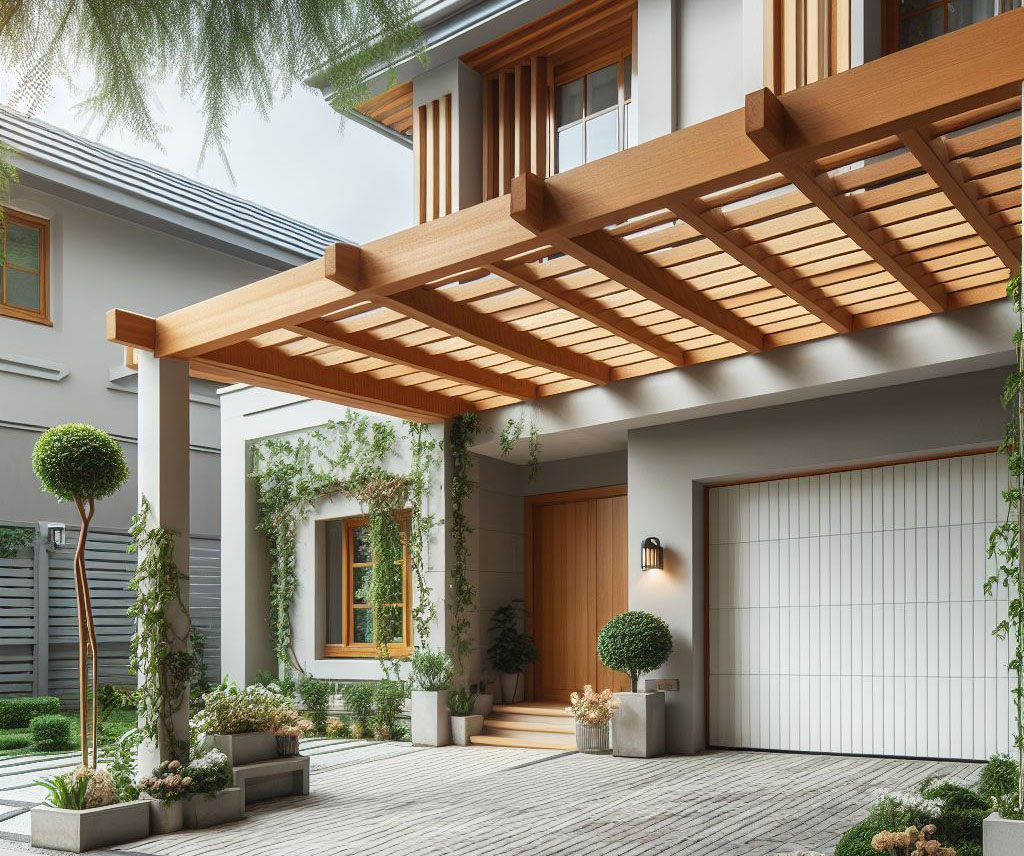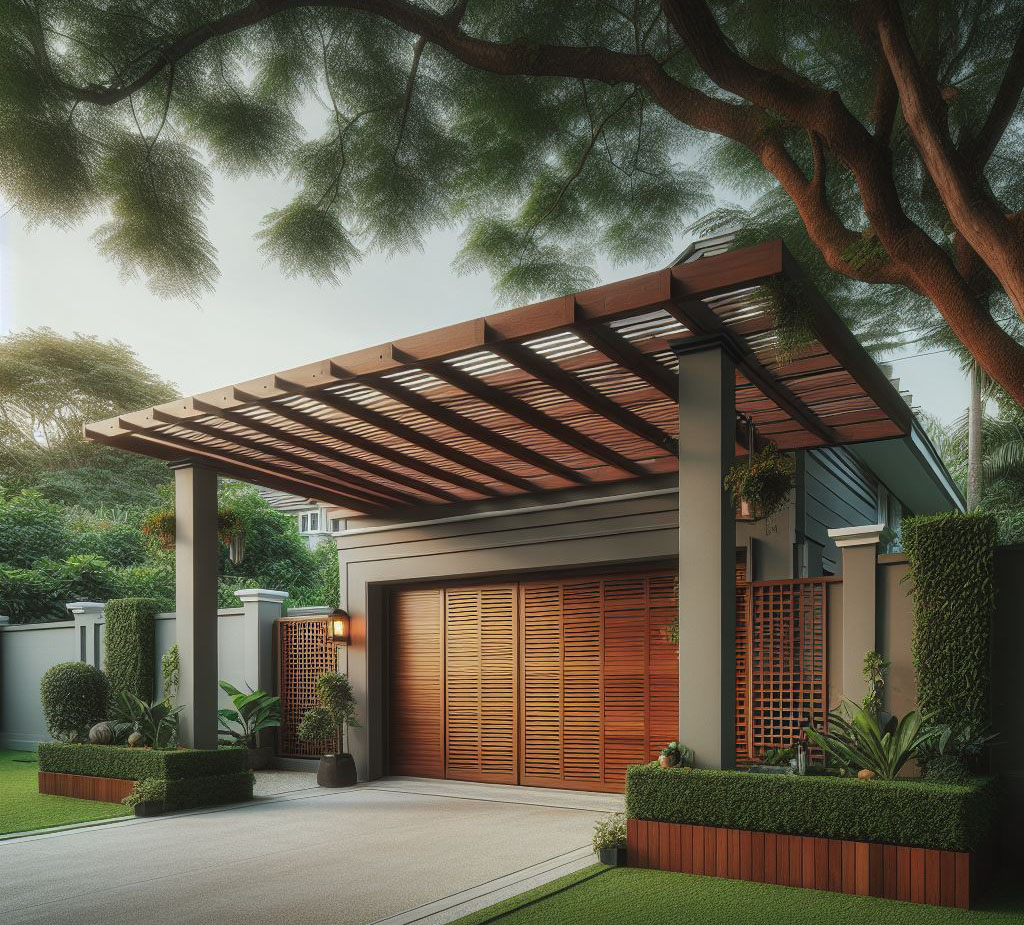In the fabric of home renovation, each element plays a crucial role in stitching together the final image of a home. The garage pergola is not just an add-on but an integral part of this tapestry, blending functionality with aesthetic appeal. A garage pergola extends beyond its physical structure, offering a combination of shade, support for greenery, and a substantial boost in the visual allure of your property.
Defined broadly, a garage pergola, sometimes referred to as a garage arbor or trellis, is a feature installed above your garage door. It’s not merely decorative, it provides a robust framework for plants to flourish, turning a simple garage door into a vibrant, living entryway.

Benefits of a Garage Pergola
- Visual Appeal: A garage pergola is an architectural accent that does more than beautify. It introduces depth and character to your home’s facade, transforming the ordinary into the extraordinary. Its contribution to curb appeal is undeniable, setting your home apart with its distinct charm.
- Property Value: Enhancing your home with a garage pergola is not just an investment in aesthetics but also in your property’s market value. It’s a strategic addition that can yield significant returns, making your property more appealing to potential buyers.
- Functionality: A garage pergola is more than its looks, it’s a functional feature that offers practical benefits. It provides much-needed shade, making your garage and surrounding areas cooler and more comfortable. For those with a green thumb, it’s a robust support system for climbing plants, creating a lush, green canopy that adds life to your home’s exterior.
Types of Garage Pergolas
- Styles: The spectrum of garage pergola styles caters to a variety of aesthetic preferences. Traditional styles exude a classic charm with intricate woodworking, while modern designs offer sleek lines and a contemporary feel. Rustic pergolas, with their robust and earthy allure, fit seamlessly into naturally landscaped gardens.
- Materials: The choice of material for your garage pergola has significant implications for both its appearance and longevity. Wood, with its natural warmth and beauty, is a timeless choice but requires regular maintenance to maintain its integrity. Metal offers unmatched durability and a modern aesthetic but can lack the natural charm of wood. Vinyl emerges as a practical alternative, offering ease of maintenance and a clean look, though it may not carry the same weight in terms of aesthetic and structural presence.
- Garage Arbor vs. Trellis vs. Pergola: It’s essential to distinguish between these terms, though they are often used interchangeably. Arbors are typically smaller structures, often used to frame walkways or serve as elegant entrances. Trellises are flat, lattice-like structures designed specifically for supporting climbing plants. Pergolas, which are our focus, are more substantial structures that create a canopy-like area, often above garage doors, providing both a visual and functional enhancement to your home.

Planning Your Garage Pergola Project
Embarking on a garage pergola project requires thoughtful consideration and meticulous planning. It’s not merely about enhancing the visual appeal of your property, it’s about integrating functionality with style, ensuring that every element aligns with your home’s architecture.
- Location and Size: Start by assessing the landscape. The pergola should be proportionate to your garage, enhancing its features without overwhelming the space. Consider the primary function of your pergola, whether it’s to provide shade, support climbing plants, or simply add an aesthetic touch, and ensure the location aligns with these objectives.
- Matching Style with Architecture: Your pergola should resonate with your home’s architectural style. A mismatched pergola can disrupt the visual harmony of your property. Pay attention to the details – the lines, materials, and overall design should complement your home, not contradict it.
- Material Selection: Selecting the right material is crucial for the longevity and appearance of your pergola. Wood offers a traditional charm but requires maintenance to preserve its beauty and structure. Metal is durable and provides a sleek look but may need treatment to prevent rust. Vinyl is a low-maintenance alternative, but ensure its style and quality harmonize with your home’s aesthetics.
DIY Garage Pergola: Step-by-Step Guide
Building a garage pergola yourself can be a rewarding experience, but it requires precision, patience, and a keen eye for detail.
- Materials and Tools: Assemble your materials – posts, beams, rafters, and hardware. Quality is paramount. Your choice of tools is equally important. Ensure you have a reliable saw, drill, level, and ladder at your disposal.
- Building Steps:
- Setting the Posts: This is the foundation of your pergola. Install the posts securely, ensuring they are perfectly vertical and stable.
- Adding the Beams: These horizontal elements support your structure. Attach them firmly to the posts, maintaining a level and consistent alignment.
- Installing the Rafters: These are the visual hallmark of your pergola. Space them evenly and secure them properly, maintaining uniformity for a polished look.
- Safety and Best Practices: Safety should never be compromised. Equip yourself with protective gear – goggles, gloves, and sturdy boots. Precision is key, so measure meticulously to avoid errors that could compromise the structure’s integrity.

Garage Pergola Kits
For those seeking a more straightforward approach, pergola kits offer a convenient solution without compromising on quality or style.
- Kit Selection: Evaluate the kit thoroughly before making a purchase. It should reflect the style of your home and fit the predetermined dimensions. Quality cannot be overstated – a robust, well-designed kit is fundamental for a successful project.
- Tips for Choosing: Scrutinize the contents of the kit and understand what’s included. Consult reviews and experiences from other homeowners to gauge the kit’s reliability and ease of assembly.
- Installation Guide: Follow the instructions meticulously. Lay out all components before starting, familiarizing yourself with each part of the kit. Proceed step by step, and if you encounter any difficulties, don’t hesitate to contact customer support for guidance.
Maintenance and Care
A well-maintained garage pergola is not just a visually pleasing addition to your home, it’s a testament to your commitment to preserving the integrity and beauty of your property. Regular maintenance is the cornerstone of ensuring its longevity and aesthetic appeal:
- Routine Checks and Cleaning: Inspect your pergola with a discerning eye, much like a craftsman scrutinizing their work. Be vigilant for signs of wear such as rot in wood, rust in metal, or chipping paint. Regular cleaning with a gentle soap solution can prevent the build-up of dirt and debris, warding off potential damage.
- Dealing with Common Issues:
- Rot: For wooden pergolas, rot can be a silent adversary. At its first appearance, apply a wood hardener, fill the gaps, and seal the deal with a coat of paint or stain to preserve the integrity of the wood.
- Rust: In metal pergolas, rust can compromise structural integrity. Remove rust with a wire brush, apply a rust-inhibitor, and finish with a coat of paint to protect against future corrosion.
- Paint Chipping: Chipped paint can mar the appearance of your pergola. Remove loose paint, sand the area smoothly, and apply a new layer of paint or sealant to rejuvenate its appearance.
Customization and Decoration Ideas
Your garage pergola is a blank canvas awaiting your personal touch. It’s an opportunity to infuse your personal style and enhance the overall aesthetic of your home:
- Paint and Decorative Hardware: Select paint colors that either complement or tastefully contrast with your home’s palette. Consider adding decorative hardware such as ornate brackets or stylish end caps to infuse character and sophistication.
- Lighting: Thoughtful lighting can transform your pergola into a captivating space. String lights can add a whimsical ambiance, while spotlights can create dramatic focal points, enhancing the structure’s architectural features.
- Plants and Vines: Embellish your pergola with plants that flourish in your local climate. Choose vines like wisteria for a lush, floral canopy or grapevines for a touch of rustic charm. Be mindful of the weight and growth pattern of your chosen plants to ensure they complement rather than compromise the structure.
FAQ Section
A garage pergola is distinctively designed to complement and enhance your garage’s architecture, providing both aesthetic appeal and functional benefits such as shade and support for climbing plants. Unlike a freestanding pergola, it’s an integral part of the garage, creating a harmonious extension of your home’s exterior.
Certainly, most garage pergola kits are designed with the DIY enthusiast in mind. They come with clear instructions and pre-cut materials, making the installation process straightforward. However, a basic level of DIY skill and the appropriate tools are necessary to ensure a successful and satisfying project.
The choice of plants should be tailored to your local climate and the specific conditions of your pergola. Sun-loving plants such as wisteria or grapevines thrive in well-lit environments, while ferns or clematis are suitable for more shaded areas. Consider the structural capacity of your pergola when selecting plants, ensuring it can support their growth over time.
The cost can vary widely based on factors such as materials, size, and whether you opt for a DIY kit or a professional installation. DIY kits can range from a few hundred to a few thousand dollars, while custom installations may increase the cost depending on the complexity and materials used.
Carefully consider the architectural style and color scheme of your home when planning your pergola. Choose materials and designs that seamlessly integrate with your home’s existing aesthetic. Attention to detail in the design and execution of your pergola will ensure it enhances the overall character of your property.
